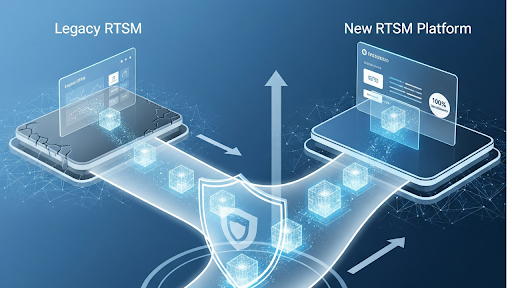|
Key Takeaways
|
Changing vendors in the middle of a clinical trial, particularly the randomization and trial supply management (RTSM), can be overwhelming to the sponsors.
However, many sponsors frequently become constrained by vendors, as protocols mature and study complexity grows, leading to compromised timelines, site satisfaction, or data quality.
With current technological expertise, it is both safe and strategic to conduct mid-study RTSM migration as a means of preserving the trial’s integrity.
When It’s Time To Change The Vendor
The following are the signs to change the vendor:
Vendor’s Underperformance: Early Warning Signs
- Reduced Responsiveness: In case response requests and support tickets are left unaddressed or project managers are regularly replaced, the systems risk operational delays.
- Functionality Differences: With the changing nature of studies, RTSM systems need to change; manual workarounds to system constraints increase data integrity and system functioning risks.
- Quality Concerns: Repeat technical problems or long response times exacerbate and usually indicate underlying system or process flows.
Assessing The Vendor Selection And Management In Clinical Trials
The choice and management of vendors in clinical trials are crucial for ensuring compliance with GCP, mitigating risks, and maintaining high standards of operations.
Why Are Sponsors Hesitating, And The Shift In Perception
Earlier, underperforming RTSM providers were tolerated by their sponsors to prevent the perceived risks of switching during the study. With a validated migration methodology and an advanced RTSM platform such as Korio, such transitions are practical and low-risk.
The Korio Clinical Approach: Seamless RTSM Migration
| S.No | Challenge | Korio’s Solution | Benefit |
| 01. | Implementation and data mapping complexity | Modern RTSM software with standardized components | Fast, highly-efficient migration and system setup |
| 02. | Data validation | Specialized migration toolkit for review/reconciliation | Proven data integrity |
| 03. | Risk of “go-live” surprises | User Acceptance Testing with real data | Sponsors preview actual experience before cutover |
| 04. | Stakeholder fatigue | Hands-on project management | Transparent, guided transition |
Table 01: Core Features of the Migration Solution
Key Migration Phases
- Assessment and Planning: The Korio team can assist in the assessment of current limitations of the RTSM and determine the appropriate time to transition.
- Data Review and Mapping: An Efficient toolkit ensures comprehensive review, validation, and reconciliation of all patient and site data before migration.
- Stakeholder Simulation: Real study data actually fed into the new system enables site personnel to probe workflows before they become operational.
- System Cutover: Korio is only implemented live with complete sponsor endorsement, which reduces the downtime and disruption.
- Continued Support: RTSM domain experts are made available to sponsors after the migration to ensure they remain informed about the realities of the trial supply and future modifications to protocols.
De-Risking RTSM Transition During Active Trials
Ensuring Data Integrity and Compliance
- Full Audit Trail Preservation: Data migration provides a chain-of-custody to be reviewed by regulators if necessary.
- Site-Centric User Experience: There is minimal navigation with integrated workflows and guidance tools that inhibit user error.
| Risk | Mitigation Strategy |
| Disrupted randomization/supply | Real-time reconciliation and UAT before cutover |
| Loss of participant histories | Complete mapping and site access tested pre-launch |
| Supply chain misalignments | Site tasks and shipments integrated seamlessly at go-live |
Table 02: Mitigating Common Risks
Best Practices For Clinical Trial Migration Mid-Study
- Choose an RTSM partner that has a record of successful migration and has dedicated, experienced project managers.
- Request a system test simulation prior to migration using real study data.
- Make transition plans to sites and stakeholders clear, as well as just-in-time training.
- Keep a risk-based migration checklist, backup plans, and quality measurements.
Is Mid-Study Migration Right For Your Trial?
Determine time availability and effect on operations. When significant obstacles have taken hold, and there is still time to go on the protocol, then remember:
The cost of “trudging through” often outweighs calculated migration risks.
Final Thoughts
With the guidance of expert partners, mid-study RTSM migration provides a strategic pathway to overcome vendor constraints and operational bottlenecks. Sponsors can ensure minimal trial disruption and data integrity with validated migration tools, comprehensive testing, and stakeholder collaboration.
This proactive approach enhances site satisfaction, supports complex protocol adaptations, and ultimately keeps trials on track and compliant.
Choosing the right migration partner and following best practices transforms vendor switching from a risk into a catalyst for trial success.
Frequently Asked Questions (FAQs)
01. What is the biggest risk in clinical trial migration mid-study?
Earlier, compromises of data integrity and hindrances to operations were key issues. These risks are now mitigated with a validated toolkit and comprehensive pre-go-live testing.
02. What is the duration of RTSM transition during an active trial?
Although the timeline varies by study complexity, the majority of the migrations can be done within weeks and not months, particularly with standardized platforms such as Korio.
03. Can sites and investigators access full study participant histories post-migration?
Yes, end-to-end data mapping and simulation testing mean that participant histories and trial supply records are readily accessible to sites following migration.
04. Is there disruption in the randomization or drug shipments with clinical trial vendor selection?
No, using Korio’s systematic method, real-time UAT demonstrates the feasibility of proceeding with randomization and supply activities with minimal disruption.
05. How do sponsors select an appropriate RTSM provider for migration?
Evaluate past migration expertise, platform flexibility, client support quality, and ability to conduct real-world user testing before launch; consult with a prospective vendor to understand their transition methodology.


